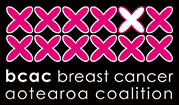October 2011.
BCAC welcomes the report released this week by Health Minister Tony Ryall which calculates the annual price of all cancers registered with the New Zealand Cancer Registry 2008. As well as calculating the costs, the report estimates the drivers and likely magnitude of price change 10 years into the future, based on previous cancer incidence projections.
Libby Burgess, BCAC Chair, says “It is encouraging to see the Government has been proactive in improving cancer treatment for New Zealanders and it is reassuring to see the analysis and forward planning that will enable the allocation of resources to ensure effective cancer treatment in the future.
“It will however take further planning and analysis to ensure New Zealanders gain early access to effective new medicines and technologies that will come on stream. These, potentially, will eventually transform cancer from a killer disease to a chronic condition.”
More than half a billion dollars a year is spent by the public health service on diagnosing and treating cancer and this is set to increase more than 20 per cent by 2021.
Health Minister Tony Ryall says, "The Ministry of Health report, Price of Cancer, tells New Zealand for the first time how much taxpayers are paying for the care of people with cancers.
"Identifying each cancer when it is diagnosed and how much it costs to treat, makes it easier to see where future cost pressures are likely and how best to manage them."
The report reveals that breast cancer, which accounts for more than 10 percent of all cancer registrations, is the most expensive cancer to treat at more than $80 million a year. This is followed by colorectal cancer and cancers of the lymph and blood, including leukaemia.
“Improvements in breast cancer treatment over the last decade have led to increased survival rates for the 2700 women diagnosed each year in New Zealand” comments Libby Burgess. “The ten year survival rate for breast cancer has risen to 85%, demonstrating the benefits of modern treatments. Early detection and the adoption of future effective treatments will further reduce the deadly toll of this disease that takes more than 600 of our women every year.”
Tony Ryall notes "The conclusion is that population growth and aging are the main reasons that the cost of cancer treatment is increasing, and improved productivity is the most effective way to contain costs."
The report does not include future cost pressures from new drugs and technologies. Neither does it take into account the costs associated with cancer prevention such as tobacco control, screening programmes, the HPV immunisation programme, and services like disability support.
The report is at http://www.moh.govt.nz/moh.nsf/indexmh/the-price-of-cancer.
Sources: The Price of Cancer: The public price of registered cancer in New Zealand. Wellington: Ministry of Health. September 2011.
Health Minister’s press release: http://feeds.beehive.govt.nz/release/price-cancer-treatment-assessed-first-time?utm_source=feedburner&utm_medium=email&utm_campaign=Feed%3A+beehive-govt-nz%2Fportfolio%2Fhealth+%28Health+-+beehive.govt.nz%29



